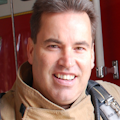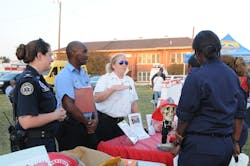I have been advocating the need for the fire service to not only evolve to meet today’s societal needs, values and expectations, but also to look inward, revisit who we truly are, and recommunicate our image and value in a manner that’s most receptive to those we serve. Doing so will better align the fire service with the values and expectations of today’s citizens, as well as reshape our vision and that of the people who will fill our ranks well into the future.
A matter of perception
What are today’s societal values? What do today’s citizens need, want and expect? I think if fire departments sent out an anonymous survey to their citizens asking them to list their current concerns and priorities, the feedback would probably surprise them. An Internet search on the topic of community concerns results in long lists, none of which, in my research, include the word “fire.” People fear crime, terrorism, lone-wolf attacks, pollution, traffic accidents, taxes and even the Russians—but not fire.
We have to ask ourselves what this means. If most of the nation has no concern or fear of fire, then what does that mean for the organization whose whole image and value is staked largely on combating it? While those of us in the fire service know our value runs much deeper than even firefighting, it doesn’t matter what we believe; it matters what our community and citizens believe.
The fire service of today exists largely in an abstract “cyber-society” driven by people on social media whose attention is on the latest headline—and it lasts just as long. The fire service of today exists in a world where face-to-face conversations and personal contact is quickly becoming a thing of the past. Yet our main duty lies at the personal level—a level that requires those personal connections in order to truly appreciate what we do and who we are.
If you lack the personal connection from which empathy and sympathy originate, how can you fully appreciate what it takes to crawl down a 500-degree F hallway in full bunker gear and drag out an unconscious adult? For most of tomorrow’s firefighters, such a task currently amounts to a video controller in a game that can be performed while sipping on soda in a climate-controlled room with the allowance of three lives to accomplish the task. There is no understanding, appreciation or value of the strength, endurance, training, risk and courage it takes to accomplish this task. If it cannot truly be understood and appreciated, then how can it be fully supported?
“Once valued”
Firefighters were once a solution to a serious national problem that brought concern and fear to the hearts of every citizen. Fire has killed more Americans and leveled more cities and communities than any terrorist, and at one time, it brought such fear to every citizen that buckets and hooks were set by the door before they laid their colonial heads down at night. The very cry “FIRE!” sent such terror through the streets that entire communities turned out to face the danger. Even the noblest of society signed up to risk their lives in the highly political and regarded society of volunteer firefighters. Times certainly have changed, and thus, so must we.
Firefighting was once a valued profession because we were the solution to a community problem that filtered into every home in America and to which no one was immune. And while fire has become more dangerous than ever before, society has changed, too. Due to the perceived advancements in fire protection, along with the fire service’s projected image of dominance in the battle against fire (“We fight what you fear” and “Slaying the dragon”), people today have lost their fear and concern of fire. This once-paralyzing fear that placed fire stations on every corner has now been replaced with whatever the headlines and media say is a threat that week. In the meantime, fire departments struggle for funding and staffing as they rush toward the flames and the numerous other daily unperceived risks of their community.
Be present at the table
What can we do? Once again, we have to become a solution, or a part of a solution, to what our community perceives as a problem. This in no way means that we forget our firefighting core or reduce our ability to solve that community problem because we are the only solution, but in order to get what we need to fulfill that mission, we also have to give the community what they need (and value) as well.
This problem came to light in my own community when a sixth-grade girl took her own life because of bullying. There was immediate community outrage and demand for action by all citizens. This story dominated the headlines for months. Rallies were held, community leaders came out in force to offer solutions, and the community unified to address an issue that was perceived as an immediate concern for every individual. A state senator formed a bullying task force and asked for volunteers to become a part. The first meeting made an incredible impression on me—plenty of law enforcement uniforms, medical uniforms, business suites and educator attire, but I was the only one wearing a firefighter uniform.
Could my fire department solve the problem of bullying? Is this even the responsibility of the fire service? No, this is not our traditional responsibility, nor can we solve the problem. But we sure can support the solution, and by showing our concern and having a seat at the table, we are again fulfilling our responsibility to serve the public through a health and safety concern. We became part of the valued solution to their perceived risk.
If my department can support the solutions by assisting others in delivering their programs, if my department can make personal contact with our citizens on a topic they perceive and value as important, if we can develop personal working relationships with other community leaders, if we can discuss our department’s abilities and needs with our politicians, and if we can come to better understand our community and other resources available, then all the better for my department and the fire service. Our presence at the table of solutions was noted by the community and its leaders.
Today’s fire service has to reconnect with our public on their terms and in a manner that they perceive and value as important to them. The only way to accomplish this in such a changing and challenging society is to present ourselves as a solution, or in support of their solution, on community issues that have their attention and fears. We have to start shouting loudly and clearly to be seen and heard over the clamor filling the airwaves in today’s communities. We cannot sit quietly behind bay doors as citizens pass by with their faces buried in their iPhones, totally oblivious to the men and women behind those doors and what it takes to crawl into hell. Any chance firefighters have to get out from behind those bay doors and connect with the community and be seen as a solution to their perceived needs, and to speak about all that the fire service offers and the challenges we face, is a win-win.
So with this in mind, what are some opportunities to connect with our public on their terms?
Each community will be different—different concerns, fears and problems. The key is for the fire department to be in constant contact and interwoven throughout the community to learn what those issues might be, what groups are forming to address them, and how the fire department can help or even take the lead.
Research county-level agencies that have clubs, groups or departments that meet to address community issues, ranging from the youth and elderly to the homelessness and poverty. Review “In the Community” sections of your local media to learn about what groups or organizations are meeting, and reach out to them if appropriate.
Attend civic group meetings like the Rotary Club, Exchange Club, Kiwanis Club, etc., have discussions with members over lunch, and listen to guest speakers; all of these actions can help get a feel for community issues. Such groups often invite speakers on topics that are making the news or are of public interest.
Of course, the fire service must remain secular and apolitical when in the public eye, and this should be considered before affiliation is made with any group or taking up a community cause.
Be the “needed solution”
We were once the centerpiece of the community when fire was the dominate threat felt by all, and like it or not, today we are in constant competition for that place of prestige that also connects to the funding pot. This is not about changing who we are! It is about realigning our services and value, as well as communicating who we are in an effective and opportunistic way.
We know our value. We know how important we are. We know our risks and needs. But it doesn’t matter what we think, know and value, but rather what our citizens who support us think, know and value. We have to meet that need on their terms and in a manner that they perceive and value, so when our citizens are thinking about their community concerns and risks, the fire department is associated with a needed solution.
About the Author

Daniel Byrne
DANIEL BYRNE is a community support officer for the Burton Fire District, Beaufort County, SC, and a retired assistant fire chief of training for the Georgia Air National Guard 165th Fire Department. A third-generation firefighter, he holds an associate degree and a bachelor’s degree in fire science as well as a master’s degree in public administration and disaster management. Byrne is an alumnus of the National Fire Academy. He received state and local awards for public relations and educational programs as well as community partnerships and served as a conference presenter and keynote speaker.
